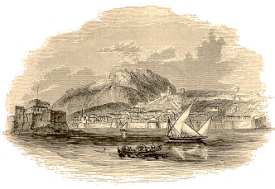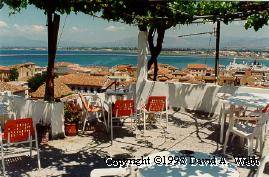

Nauplio (New!
Read W.M. Leake's account of Nauplio: pre-1830)
 The
Ancient Town
The
Ancient Town
The town of Nauplio (alternately known as Nauplia, Nauplion,
Nafplio, and Nafplion) is not known today for its archaeological sites.
In ancient times it was a port for the nearby cities of Argos, Mycenae,
and Tiryns, and its name suits it well. It was mentioned by Herodotus,
Strabo, and in Euripides' Orestes, Menelaos docks his ships here
on his way back to Sparta following the Trojan War. The site was
occupied throughout antiquity and just last year emergency excavations
confirmed occupation of the eastern part of the modern town during Early
Helladic, Mycenaean, and Byzantine periods. Though visitors today
will not be able to see any ancient sites in Nauplio, it has a terrific
archaeological museum and it can serve as a perfect base for your other
visits throughout the Argolid.
The Archaeological Museum
On the west side of Plateia Sindagmatos, you will find
the large archaeological museum. The museum itself is located on
the second and third floors of the building. The building itself
was once a Venetian arsenal but today it houses items from Mycenae, Tiryns,
Dendra, Asine, Halieis, and of course a few from Nauplio. Some of
the more notable items on display include a bronze cuirass from the Mycenaean
period, a helmet made of boars' tusks (that does not belong with the suit
of armor it is displayed with), and numerous pottery displays. Some
of the most interesting pieces of pottery include the terra-cotta idol
known as the "Lord of Asine," grotesque 8th century BCE masks, and numerous
other Mycenaean wares. The museum is closed on Mondays.
 The
modern town
The
modern town
One of the most enjoyable towns I stayed in on my entire
trip, Nauplio (10,609 inhab.) is just the right size. The modern
visitor probably will confine his or her ramblings to the old part of the
town, which was built mainly during the second Venetian occupation (1686-1715),
but you will undoubtedly go through the newer section to the east upon
entering or leaving. For some of the same reasons you are here though,
others will be too, and sometimes it may get a little crowded. You
may have to look around for a good deal on a room, but the first time I
visited I was lucky and found an inexpensive room near the top of town
which had a rooftop patio. I also met some very nice people from
Singapore and France (Chong, Rick, and Myriam) in Nauplio and we had a
great time while we there. Nauplio, the first capital of liberated
Greece (from 1829-1834), has a wonderful town square that supposedly
has not changed very much in the last few hundred years. Kids play
soccer on the courtyard while others sit on the museum steps. There
are a number of restaurants on the square also. The Castle
of Palamidi at Nauplio is located at the top of 999 steps (quite high),
but it is worth the climb once you get to the top. The view is absolutely
stunning and you can experience it to a small degree by following the link
below where you can load a 360 degree view from the fortress. It
may look impregnable, and indeed it was thought to be so. After all,
it was designed by LaSalle in 1711, but in battle it fell after only an
eight day siege.
There is a small beach on the south side of town and you can take a boat out (5 min.) to the island fortress, Bourdzi, where the wildflowers growing from the walls of the building are quite stunning. Try taking a walk around the promontory, Its Kale, on the path just above the water's edge. Also in Nauplio, though I did not go there, is the Peloponnesian Folklore Foundation (link below). You can also catch a bus to almost all the other sites in the region from here. Some big cruise ships put in at the port with day trips to Mycenae or Tiryns or even Epidauros. Also, for some strange reason, I had even better phone connections while I was at Nauplio than in many places in Athens. Cheaper and fresher fruit than in the cities can be found here too.
Where to stay and eat
On my first visit, I did not write down the name of the
domatia that I stayed at. After looking at another description elsewhere,
I think it may have been Dimitris Bekas' Domatia (tel 24 594).
Doubles run about 4500 drx. per night. To reach it, turn up the stairs
onto Kokinous, following the sign for rooms off of Staikopolou. Climb
to the top, turn left and then climb another 50 steps. The rooms
are ok but the view is amazing. In the summer of 1998, our group
stayed at the Hotel Dioskouri. It is located at 6 Vyronos
& Zygomala, toward the extreme west end of town and up. Rooms
run around 13000 drx. per night for a double. You do get your own
bathroom though, and a small balcony if you get the right room. I
have seen the King Othon mentioned as an inexpensive location with
big rooms (under 8000 drx. per night). It is located on Farmakopoulon
3, but it only has 12 rooms.
